The Stephen Petronio Company at Skirball
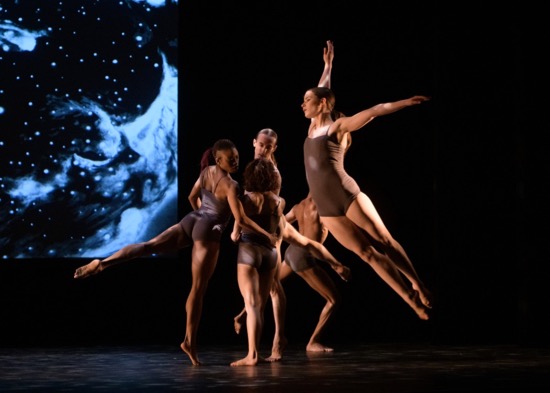
American choreographers in the modern dance world have tended to disavow their heritages as they made new discoveries. In the 1930s, Martha Graham and Doris Humphrey labored to find their own styles and disavowed any influence that might have trickled down from Ted Shawn and Ruth St. Denis, in whose companies they had danced. Did Merce Cunningham and Erick Hawkins acknowledge carrying forward into their own work what they had learned while dancing Graham’s choreography? Are you kidding? Steve Paxton performed in Cunningham’s company, but watching his own work, you might not have guessed that.Stephen Petronio initially got our attention as the first male dancer to join Trisha Brown’s company; he founded his own group in 1984 while still dancing with her. He, unlike some of those listed above, honored the influences that slipped onto his body and into his choreography, whether these were visible or not. Since presenting his Bloodlines project in his company’s 2014-2015 season, he has re-introduced audiences to eleven works by Cunningham, Brown, Paxton, Anna Halprin, and Yvonne Rainer. His recent season at NYU Skirball added Rudy Perez’s 1970 Coverage Revisited and a revival of Cunningham’s Tread (also 1970) to a program featuring his own new American Landscapes.
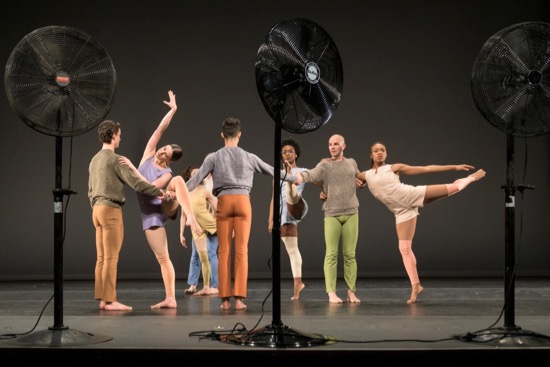
In Tread, staged by Jennifer Goggans, the ten performers (including guest artist Brandon Collwes, like Goggans a former Cunningham company dancer) spend a lot of time sitting on the floor or standing around to watch what’s going on; they leave; they return. On their own, they’re powerhouses—sleek, up for anything: leaping, hopping, tilting, falling, rolling, lunging, using one leg like a pointer, flicking their feet busily around, whirling an arm, working out a complex collaboration among their limbs. However, as is usual in a dance by Cunningham, they don’t seem flung about the stage by inner tempests or imagined gales. They’re alert, mostly erect, aware of what they’re doing and what they need to do.
Bruce Nauman’s set for Tread consists of ten tall standing fans lined up across the front of the stage. Every other one is turning back and forth as it blows. After a while though, you hardly notice this gleaming army separating the dancers from the audience. At the Saturday performance, Seth Cluett, John Driscoll, and Phil Edelman of Composers Inside Electronics (CIE), the musicians playing Christian Wolff’s For 1, 2, or 3 People in the pit constitute another formidable dividing line. Behind these, Petronio’s dancers, wearing brightly colored practice clothes based on Cunningham’s designs, create a rumpus of movement.
Pretty soon you notice that in this world, people expect to help one another. Tess Montoya may dance briefly alone and in silence. Nicholas Sciscione may embark on a solo that involves shaking his hands vigorously. Two may work together: Megan Wright, say, and Collwes, or Bria Bacon and Ryan Pliss. But often people will get themselves into a complicated position, and someone else will come up and rearrange them or disentangle them. Ernesto Breton is hoisted by Sciscione, Pliss, and Mac Twining and set down elsewhere. No one—including Taylor Boyland and Jaqlin Medlock—objects to being moved around or helped into something new and interesting, even when the task gets awkward (two of the men, spraddled-legged, waddle along, one behind the other, lugging a third man who’s prone under the arch of their bent legs).

Your pulses have to slow down quite a bit after the fans have been unplugged and pulled away on little wheeled platforms so that Rudy Perez’s Coverage Revisited can begin. Perez, once a New Yorker, has lived and worked in Los Angeles for decades, and Sarah Swenson helped him coach Ernesto Breton in the solo. I saw Perez (who had made his debut at Judson Church) perform it in 1970 at the Cubiculo, 414 West 51th Street in Manhattan, in a concert that included his colleagues, Barbara Roan and Anthony La Giglia. The white-painted brick space was below street level and deeper than it was wide. I, three years into my new career as a dance critic, wrote that “His own performing style is suffused with emotion and motion kept back. He edges from stillness into motion as if dancing were a chasm from which no return would be possible.”
Ernesto Breton, taking on the role, is not as solidly built as Perez was back then, but meticulously assumes the stolidity and the control. Wearing white coveralls, sneakers, and a royal blue helmet, he is captured by Joe Doran’s lighting in mid-step, profile to the audience. We hear a newscaster’s voice, traffic sounds, street protests, a marching band, more. Blackout. Lights up. He’s in the same arrested stride but in another place onstage. When he begins to move, it’s to march toward us and then side-step upstage, his gaze steady. Once, briefly, he stands, his arms spread out to either side, wrists flexed, as if he’s stopping traffic in both directions. His shoes squeak with his footfalls.
Matter-of-factly, without any extraneous moves, this worker lays lines of tape along the stage floor to form a square and in this carefully delineated space, removes his helmet and his coveralls. I think I hear a voice, buried in the sound assemblage, say “Ay, muerte!” I hear two clangs, as if from a trolley. In his underpants, Breton is still controlled, even when walking, running in a circle, falling slowly backward, or jumping as if to get a ball in a basket.
In 1970, the war in Vietnam was winding down, and anti-war protests were escalating. Coverage Revisited ends with the then-familiar voice of Kate Smith singing “God Bless America.” Breton, having stepped back into his coveralls and put on his helmet, stares in our direction, removes the helmet, and places it not over his heart, but over his crotch.
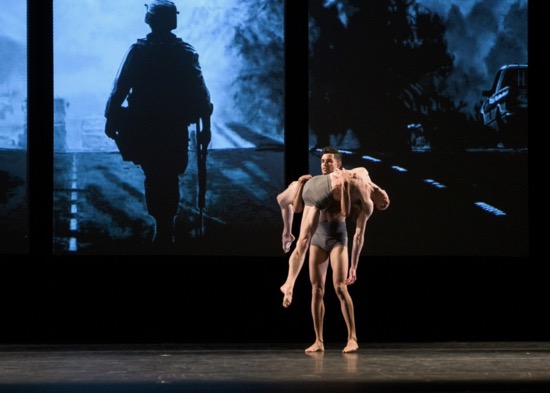
Only in retrospect did I think of the three dances making up the Stephen Petronio Company’s performances at the Skirball in relation to one another. The intricate, watchful, apparently light-hearted experiments in a curiously guarded atmosphere; one man’s statement during a dragging-on war that many condemned; and Petronio’s new and gripping American Landscapes.
The piece is set to a commissioned score by the adventurous lutenist/composer Jozef Van Wissem and Jim Jarmusch (filmmaker/guitarist/composer/electronics expert), who have collaborated on three albums so far. The music has a mournful, obsessive kind of beauty, as if it were being dropped bit by bit into a bottomless hole. I’ve read that it draws on “multiple historical renditions of the poetry and anthem “America the Beautiful.” Projections by Robert Longo appear on all or part of a huge, three-paneled screen designed by Don Cieslik. You may at first think you’re seeing black and white photographs, but these are actually charcoal drawings on paper. Among them are images of congested city streets, two men in cowboy hats, a football player taking a knee, an airplane, an atomic bomb cloud, a ruined church, but also ones of earth as a globe, of a giant tree, of cloud-infested skies, and of a huge, curling ocean wave—like something out of Japanese print. You can compare one view of an American flag blowing in the wind with a later one whose edges are frayed and torn.
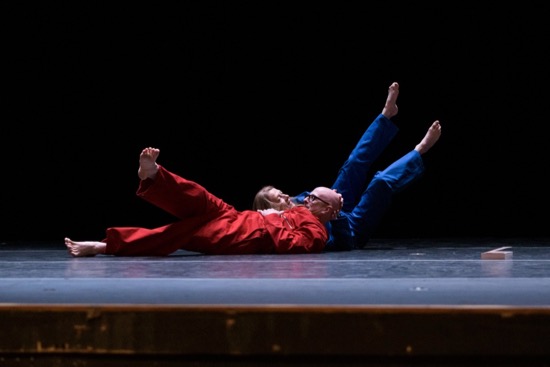
An enigmatic prologue features Petronio and Martha Eddy, an expert in Somatic Education and Therapy. She met and danced with him when both were students at Hampshire College in the 1970s. Maybe that’s why they— talking and laughing silently together—come together in a ballroom-dance position now and then and do a little casual waltzing. Faintly resembling astronauts in their jumpsuits (red for him, blue for her), they peruse a book (I later learn it’s A People’s History of the United States by scholar and activist Howard Zinn); the white pages they turn, plus their outfits, make up the colors of the U.S. flag. Feet well apart and leaning together to form a slightly wobbly pyramid, they walk along. Like college pals studying together, they point out meaningful passages in the book and lie supine, his head on her belly. Her last act is to advance toward the audience alone, opening her arms to us, then retreating.
The dancers appear as if summoned up. All are clad in gray: sleeveless leotards for the women, high-waisted trunks for the men (costumes by H.Petal). They paint with their bodies and with their adventures what one piece of publicity refers to as “kinetic canvases.” I would have to see American Landscapes again to be able to fathom the subtle coincidences between the projections and the dancing. Imagine, for instance, that you see that huge breaking wave looming over the stage and at some later point see the dancers, holding hands, make a movement ripple down a line. Later still, in another line, they stumble and fall, but, buoyed up by their colleagues, keep going. A filmed airplane passes; people drop to the ground as if hit. Petronio doesn’t stress any such possible connections.
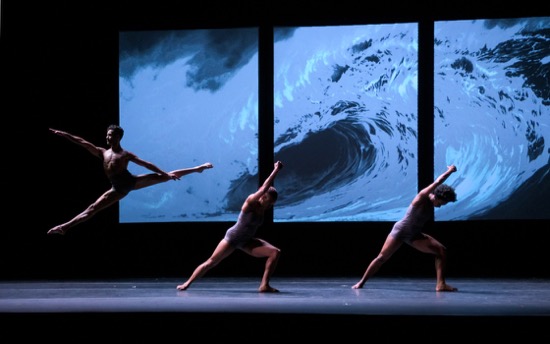
Against this backdrop, the nine dancers show us people collapsing, people collaborating to lift a fallen one. How does a lunge become a prayer? What brings two people together in a duet? What does unison signify? When does a leap look like an explosion? What does running in a circle connect to? But understand this: Petronio’s people don’t appear to rest; they dance as if the world would stop if they didn’t keep going. Not for us—that is, not aimed at us, but on our behalf. Today, across our country, hatred flares. Money corrupts our democracy. The polar ice is melting. The spire of the ancient Paris cathedral, Notre Dame, just went down in flames. Can a beautiful, piercing leap say no to these? Let’s try it and see.
